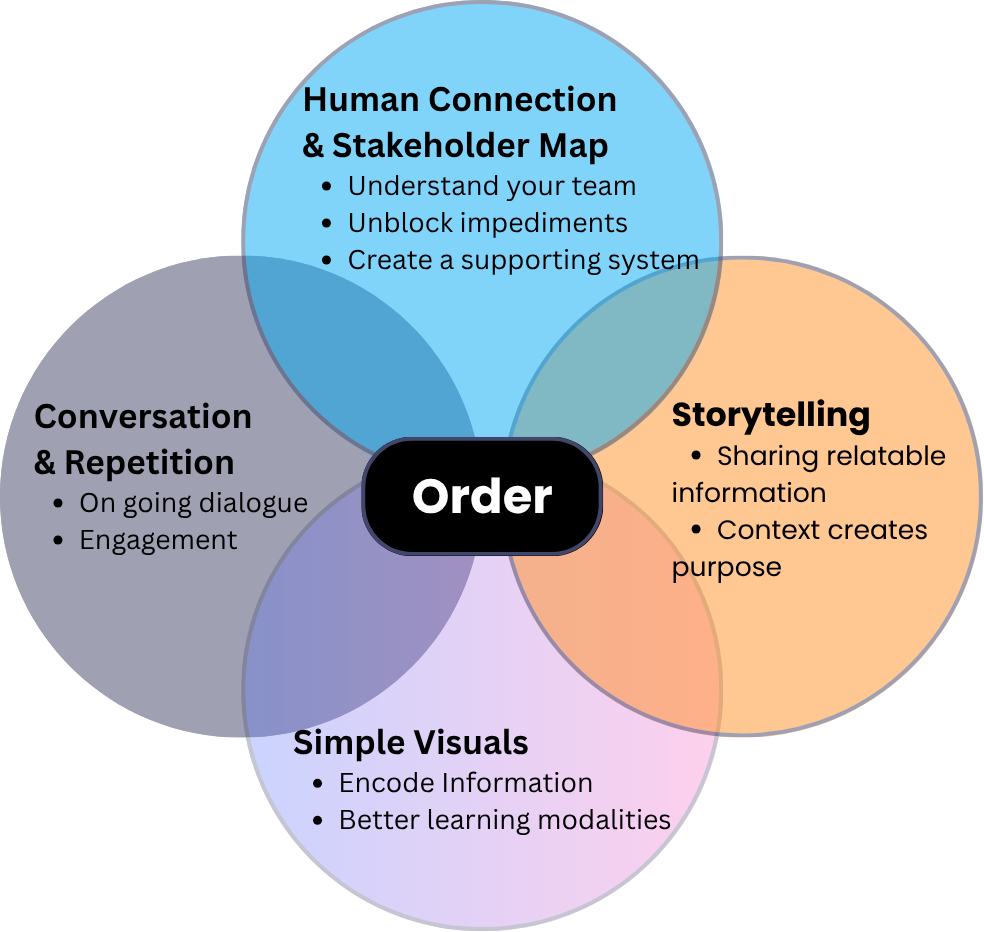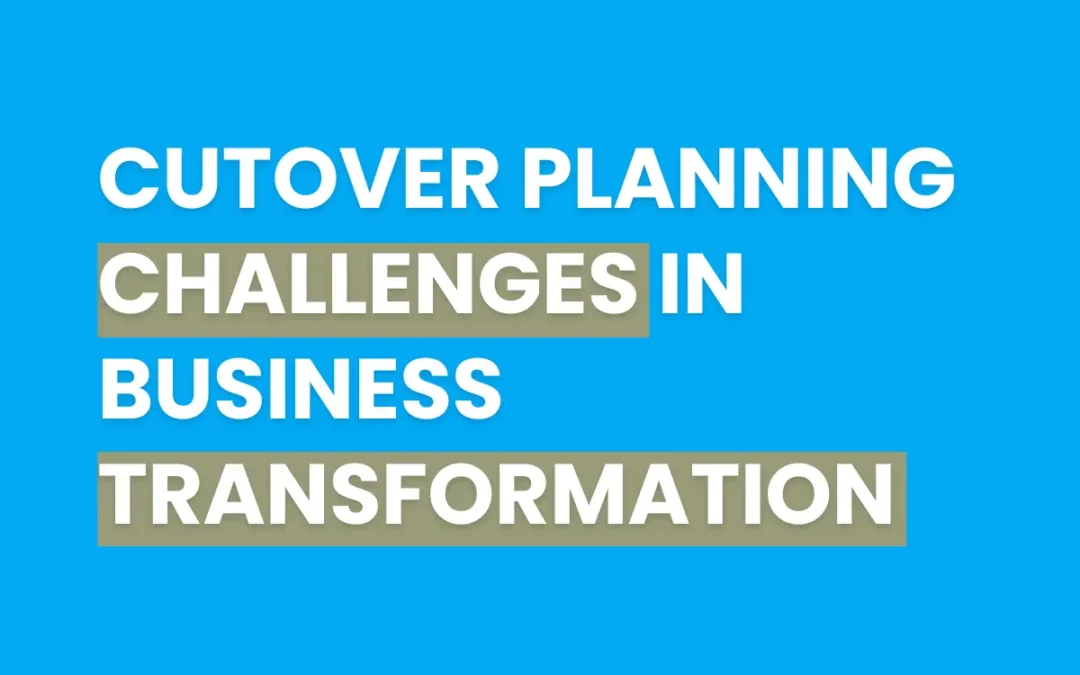How to Bring Order to Chaos: Cutover Management Guide 2025

The Context: When Workplace Chaos Management Becomes Critical
When we’re brought into a program, it’s typically been running for 1, 2, or even 3 years due to delays. We start with just 6 months to establish three critical elements: Order, Strategy, and Detailed Planning.
Here’s what we see quite often:
After years working on the same program, people begin operating in isolation—sometimes even intentionally. Team members focus solely on their areas and progressively distance themselves from the big picture, moving away from the “ONE TEAM” mentality we hear about everywhere.
From one day to the next, coworkers lose their sense of belonging to something meaningful and forget the real objective of their daily work. Over time, some change functions within the program, new people join, some expand beyond their original scope while others narrow their focus just to get things done and avoid being pulled in every direction for nothing.
People don’t know what other teams are doing, don’t know who to contact to move forward, get lost in heavy processes, and lose hope. Communication is no longer fluid.
Every step feels like a mountain to climb, and there’s no energy left to climb even a tree. The teams become fragmented, and so does the program.
Step 1: Build Trust and Master Stakeholder Mapping Techniques
Being the newcomer, I arrive fresh and full of energy. Every day brings new learning, and I’m genuinely excited about the possibilities.
In about 6 months, during cutover execution, I’ll have less than a minute to react to an issue and bring the right person into the room—someone capable of fixing that problem immediately. I need to fully understand everyone’s job, area of expertise, skills, and strengths.
During the first 2 weeks, I meet every single person one-by-one to create connections and build trust.
The Key Questions for Effective Team Alignment
“What are your current day-to-day activities within the company and program?”
Titles don’t mean much nowadays. I need to understand their actual functions and how they contribute to program progress.
“What’s your biggest challenge right now? And what’s your biggest concern about the program?”
I distinguish between “challenge” (associated with feeling stuck) and “concern” (associated with worry). These answers help me in three ways:
- Better understand their pain points and find the best collaboration approach
- Define patterns and priorities—if one concern comes up repeatedly, it becomes my number one priority
- Identify where I can add value from day one, removing impediments to create more space around the cutover
“Have you participated in a cutover before?”
This helps me adapt my communication level and terminology, and estimate how much time I’ll need for the educational component.
“Who do you recommend I connect with who might be crucial for Go Live from your perspective?”
This reveals the internal network and hidden influencers.
From these conversations, I build my Stakeholder Map—my “Contact Bible” that I carry everywhere and keep updating until Hypercare. I make sure it’s accessible to everyone.
Every time someone asks, “Who do I need to contact for XYZ?” I:
- Confirm the context and what they need
- Provide my recommendation for the best contact
- Share the Stakeholder Map and ask them to save the link in their favorites
Step 2: Master Project Orchestration Through Storytelling
We often describe cutover as “The Art of Work Orchestration,” which I believe is 100% true. It’s an art to orchestrate hundreds of people where everyone has a role to play, and a single false note can break the symphony.
The problem is we’re only talking about “Cutover Execution”—not all the months of preparation before the controlled chaos begins.
The Cutover Journey as Strategic Narrative
The cutover is, first and foremost, a logical sequence of events. In other words, it’s a sequence of small acts that tell a story.
Have you ever watched a movie where, 10 minutes before the end, one scene gives you goosebumps and you think, “Now it all makes sense!” Suddenly, all the previous scenes click in your head.
That’s what I’m aiming for—that moment of clarity!
During cutover workshops (where we invite only relevant people based on our updated stakeholder map), we break down concepts, activities, and dependencies to the lowest level.
Some people don’t like when I say I tell stories like I’m speaking to a child. I have tremendous respect for all the highly skilled professionals around me, and I’m never treating them like children by saying this. My top priority and objective is ALIGNMENT.
You need to adapt your communication to the simplest level possible—to the point where 2 + 2 = 4, and no one can dispute or misunderstand that.
When we connect the dots, it gives purpose.
Too often, program management assigns tasks in isolation without context or reasoning.
Version 1: “Could you please complete data cleansing, doing X, Y, and Z?”
Version 2: “The new system will enhance how we report and manage employees within the company through its unified data storage approach. Once we extract data from the legacy system and start loading, we won’t be able to completely roll back due to data integrity risks. We need to ensure our current data matches the future state before extraction to secure data migration and save time on data reconciliation. Let’s complete the data cleansing, making sure X is… Y is… and Z is…”
Which one makes more sense?
Using storytelling while sharing relatable information provides a sense of purpose, increases engagement, enhances collaboration, and brings clarity.
Step 3: Implementing Cutover Planning Best Practices Through Visual Content
We all know these two principles:
- “A picture is worth a thousand words” (though you still need both)
- “Less is more” (simple design for large concepts)
The Science Behind Visual Learning in Project Management
The cornerstone of modern understanding about how the brain processes information lies in Allan Paivio’s dual-coding theory, first proposed in 1971. This theory fundamentally changed how researchers conceptualize learning by proposing that the mind processes information along two distinct channels: verbal and nonverbal.
According to this framework, humans possess separate cognitive subsystems—one specialized for processing linguistic information and another for handling imagery and spatial information.
Visual information processing represents one of the most powerful learning modalities, supported by robust evidence for what researchers term the picture superiority effect. This phenomenon demonstrates that pictures and images are consistently more likely to be remembered than words across numerous experimental conditions. The effect occurs because pictures are encoded through both visual and verbal pathways, whereas words typically generate only verbal codes.
Richard Mayer’s cognitive theory of multimedia learning demonstrates that people learn more effectively when information is presented through both visual and auditory channels simultaneously, rather than through either channel alone.
Successful multimedia instruction requires careful attention to channel capacity limitations. The visual channel can become overloaded when too much information appears on screen simultaneously, while the auditory channel can be overwhelmed by excessive simultaneous verbal input. Research shows that distributing essential processing across both channels, rather than concentrating it in one, significantly improves learning effectiveness and reduces cognitive overload.
The brain absorbs information better through the combination of both visual and speech.
In the brain, the memory of a simple picture on a slide triggers associated conversations that occurred during the presentation, creating stronger recall pathways.
Step 4: Advanced Team Alignment Strategies Through Conversation and Repetition
Learning through conversation and social interaction activates specialized cognitive mechanisms that differ substantially from individual study methods. Social learning research reveals that when people learn material in the company of others, they encode information more robustly and demonstrate enhanced motivation to apply new knowledge. This effect occurs because humans have evolved to encode social information automatically—group connection has always been essential for survival.
However, conversational learning faces significant challenges regarding information retention. Studies of conversational memory reveal surprisingly poor recall rates, with participants remembering only approximately 10% of conversation content immediately after interactions, declining to just 4% after one month. This dramatic forgetting occurs because conversations typically lack the structured organization and repetition that facilitate long-term memory formation.
Social learning effectiveness depends on the degree of social interaction present during learning episodes. The testing effect, also known as retrieval practice, shows that long-term memory improves significantly when learning sessions include active recall rather than passive review. This effect occurs because retrieving information from memory strengthens neural pathways and enhances the accessibility of stored knowledge.
Bringing Order to Teams: The Complete Transformation
Step by step, everyone:
- Knows their coworkers better
- Has greater clarity about the purpose of their activities
- Is more engaged with their peers
- Has clear direction and understands the path to Go Live
You are now back in order and feel at peace. The chaos has transformed into orchestrated harmony, and your team is ready to execute a successful cutover.
Key Takeaways for Successful Cutover Management
Remember: The key to bringing order to chaos isn’t just about processes and procedures—it’s about reconnecting people to purpose, each other, and the bigger picture they’re all working toward.
This comprehensive approach to cutover management ensures that your team transitions from chaotic dysfunction to organized excellence, creating lasting positive change that extends far beyond the immediate project goals.


